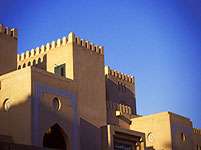By Lalaine C. Delmendo
The opening of Oman’s real estate market to foreigners began in 2002, as part of the “Vision 2020” plan, which aimed to diversify Oman’s economic base and reduce its dependence on oil revenues. In December 2002, GCC nationals gained the right to own real estate for residential or investment purposes. In February 2006 other nationalities were also given the right to own real estate, but only in Integrated Tourism Complex (ITC) developments.
Recently, the government has been again considering opening up more areas for foreign homebuyers, hoping to buoy the property market. The recommended reforms include allocating special zones where expats can buy properties at more reasonable prices as compared to tourist complexes.
Under current laws, expatriate owners automatically get residency rights for themselves and their immediate families when they buy property in designated ITC developments.
Growing expat numbers fuelled a real estate boom. The expat population rose by more than 12% per annum during the period 2004-2015, and by Q1 2016 there were more than 2 million expats in Oman, according to the National Centre for Statistics and Information. The expatriate workforce reached 1,747,000 in Q1 2016.
Foreigners account for almost 90% of all workers in Oman’s private sector, according to the Manpower Ministry. Oman’s population is 57% native Omanis and 43% expatriates, far from the 75:25 ratio of Omanis and expats in 2004. Oman’s population is young, with a median age of 24.9 years. Oman’s total population was 3.84 million in 2015, and has been growing at an annual average rate of 3.6% since 2004.
The major ITCs such as Al Mouj Muscat (formerly The Wave) and Muscat Hills Golf and Country Club have led the country’s housing market in terms of growth and value. In recent years, these ITC developments have continuously attracted owners and tenants, with “virtually zero” vacancies and high rents, according to Savills Oman.
ITC prices fell during 2009, but these properties remain in demand due to their superior design, setting and facilities. In Al Mouj Muscat and Muscat Hills, resale values of apartments are stable, according to some local property experts.
Homebuyers are now leaning towards lower priced residential properties. This is reflected in the latest sales transactions figures from the National Centre for Statistics and Information, which showed that transaction volumes increased in the first two months of 2016 from a year earlier but traded value declined substantially to OMR 563 million (US$ 1.46 billion) in Jan-Feb 2016, from OMR 1 million (US$ 2.6 billion) in the previous year.
AVERAGE SALES PRICE IN THE SECONDARY MARKET FOR ITC PROPERTIES, Q2 2016 |
||||
| Property type | Property price (OMR) | Property price (USD) | ||
| Lowest | Highest | Lowest | Highest | |
| Apartment | ||||
| 1 bedroom | 48,000 | 120,000 | 124,708 | 311,769 |
| 2 bedroom | 65,000 | 170,000 | 168,875 | 441,673 |
| 3 bedroom | 90,000 | 340,000 | 233,827 | 883,347 |
| Villa | ||||
| 3-4 bedroom | 325,000 | 400,000 | 844,375 | 1,039,232 |
| 4-5 bedroom | 420,000 | 890,000 | 1,091,193 | 2,312,290 |
| 5+ bedroom | 490,000 | 1,300,000 | 1,273,059 | 3,377,503 |
| Source: Savills Oman | ||||
Aside from the continuous interest in the ITCs, there have been significant ‘off plan’ sales of new apartment developments in the Muscat neighborhood. Demand has been driven by younger Omanis, who buy 75% of all central area developments, according to Savills Oman. These well-educated and savvy individuals are eager to create their own investment portfolios, buying units they intend to lease out upon completion.
Aside from younger Omani buyers and Gulf Cooperation Council (GCC) nationals, other groups such as Syrians, Iranians also buy houses in the Sultanate.
Newly launched off-plan apartment developments in Oman, Q2 2016:
- In Ruwi/East of Centre, the main business and commercial district of Muscat, prices of one-bedroom apartments start at OMR 30,000 (US$77,942), according to Savills Oman. Two- and three-bedroom apartments are offered in the market for as low as OMR 45,000 (US$116,914) and OMR 60,000 (US$155,885), respectively.
- In Qurum, Muscat’s upmarket suburb, prices of one-bedroom apartments range from OMR 38,000 (US$98,727) to OMR 45,000 (US$116,914). Prices of two- and three-bedroom apartments start from OMR 65,000 (US$168,875) and OMR 85,000 (US$220,837), respectively.
- In Al Khuwair, one-bedroom apartments are priced from OMR 38,000 (US$98,727) to OMR 45,000 (US$116,914). Prices of two-bedroom apartments start from OMR 65,000 (US$168,875) while for three-bedroom apartments, prices start from OMR 85,000 (US$220,837).
- In Bausher, one of the newly established residential areas in Muscat, one-bedroom apartments are priced from OMR 33,000 (US$ 85,737) to OMR 45,000 (US$ 116,914); two-bedroom apartments, from OMR 45,000 (US$ 116,914) to OMR 65,000 (US$ 168,875); and three-bedroom apartments, from OMR 70,000 (US$ 181,866) to OMR 75,000 (US$ 194,856).
- In Al Mawella/East of Centre, one-bedroom apartments are offered for as low as OMR 25,000 (US$ 64,952) while two-bedroom apartments are priced from OMR 30,000 (US$ 77,942). Prices for three-bedroom apartments range from OMR 35,000 (US$ 90,933) to OMR 40,000 (US$ 103,923).
The housing market is expected to remain steady in the coming months, amidst weakening economy. The economy is projected to expand by just 1.8% this year, down from an annual growth rate of 4.1% in 2015, and the lowest growth since 2004, according to the International Monetary Fund (IMF).
Oman mulls opening more areas for expat homebuyers
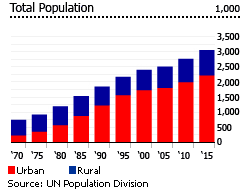
Recently, the government, together with Oman Real Estate Association (OREA), has been considering opening up more areas for expats and foreign homebuyers.
The problem is that many of the integrated tourist complexes are beyond the means of lower paid expats living and working in Oman. The recommended reforms include allocating special zones where expats can buy properties at more reasonable prices as compared to tourist complexes.
“This has to be done on real demand, and not as a speculative market, where buyers purchase a house with the hope that it will become more valuable at a future date,” said OREA vice chairman Hassan Juma.
The reform, if approved, is expected to boost Oman’s real estate market.
Rents are falling
A few years back, Cluttons forecast that a two-tier market would develop. Properties well-matched to tenant desires in terms of quality and design would have high occupancy rates and relatively stable rental values. Poorly built properties would have declining rents, and be mostly uninhabited.
This is largely what has happened. There has been a continuous drop in demand and declining rental levels for older-style properties in the established central areas. The take-up of these properties has been very slow, due to a surge of new modern apartments with amenities and finish meeting international standards.
Rents have however remained stable in most areas. There have even been slight rises in areas benefiting from the improved accessibility brought by the Expressway and new interchanges.
In Q1 2016, rents across Muscat fell by 12.1% from the previous year, its third consecutive quarter of rent declines, according to Cluttons. The villa market headed the drop, with monthly rents falling by around 14.1% in Q1 2016 from a year earlier.
Monthly rents for two-bedroom apartments in central areas (excluding ITC’s) in Q2 2016 range from OMR 300 (US$ 779) to OMR 1,100 (US$ 2,858), according to Savills Oman, slightly higher than rents during the second half of 2015. Rents for 3 bed villas range from OMR 350 (US$909) to OMR1,750 (US$4,547). Rents for 4 bed villas were around OMR 450 (US$ 1,169) to OMR 2,500 (US$ 6,495) in Q2 2016.
In Q2 2016, rents in Al Mouj Muscat (formerly known as The Wave) range from OMR 850 (US$ 2,208) to OMR 2,500 (US$ 6,495) depending on the housing type, while rents in Muscat Hills range from OMR 725 (US$ 1,884) to OMR 2,300 (US$ 5,976).
Cluttons notes that rents during 2016 are likely to fall further – by up to 10% across Muscat. Better quality properties priced reasonably, at between OMR250 (US$) to OMR500 (US$) are likely to remain stable.
“With an economic turnaround unlikely over the short to medium term, it is our expectation that the rate of job creation and therefore demand for rented accommodation will continue to decline over the next six to twelve months, putting rents under further downward pressure,” said Cluttons.
There are more than 1,600 new rental apartments in central areas to be completed over the next 12 months, according to Savills Oman.
Monthly Rents, Q2 2016 |
||||
| Area | 2-BR apartments | 4-BR apartments | ||
| OMR | USD | OMR | USD | |
| Wadi al Kabir | 350 – 450 | 909 – 1169 | 450 – 650 | 1169 – 1689 |
| Ruwi | 300 – 350 | 779 – 909 | 450 – 500 | 1169 – 1299 |
| Darsait | 300 – 400 | 779 – 1039 | 450 – 650 | 1169 – 1689 |
| Al Wattaya | 350 | 909 | 450 – 550 | 1169 – 1429 |
| Qurum | 350 – 450 | 909 – 1169 | 850 – 2500 | 2208 – 6495 |
| Qurum Heights | 450 | 1169 | 950 – 2500 | 2468 – 6495 |
| Medinat al Ilam | – | – | 1100 – 2200 | 2858 – 5716 |
| Medinat Sultan Qaboos | 750 | 1949 | 1500 – 1800 | 3897 – 4677 |
| Al Khuwair | 450 – 750 | 1169 – 1949 | 850 – 2500 | 2208 – 6495 |
| Shati al Qurum | 775 – 850 | 2014 – 2208 | 1700 – 2500 | 4417 – 6495 |
| Ghubrah North | 550 | 1429 | 850 – 2000 | 2208 – 5196 |
| Ghubrah South | 450 | 1169 | 850 – 1000 | 2208 – 2598 |
| Al Mouj | 850 – 1100 | 2208 – 2858 | 1750 – 2500 | 4547 – 6495 |
| Muscat Hills | 725 – 775 | 1184 – 2014 | 1350 – 2300 | 3507 – 5976 |
| Azaiba | 525 – 750 | 1364 – 1949 | 850 – 1500 | 2208 – 3897 |
| Bausher | 600 – 650 | 1559 – 1689 | 1000 – 2000 | 2598 – 5196 |
| Seeb | 350 | 909 | 700 – 1000 | 1819 – 2598 |
| Al Khoud/Al Hail/Mawelah | 350 – 400 | 909 – 1039 | 550 – 800 | 1429 – 2078 |
| Source: Savills Oman | ||||
A less-restricted rental market
Rental laws in Oman were last changed by the amended Royal Degree (107/2010). New rules included:
- The rule that landlords may only increase rent every 3 years was modified. The parties can now agree otherwise.
- The maximum rent increase of 7% of the annual rent stipulated in the lease contract has been removed.
- The earliest period that a landlord can terminate a lease for commercial property was trimmed down to 5 years, from the previous 7, and from 4 to 3 years, in the case of residential properties.
- Landlords can now retrieve expenses incurred in lawsuits related to eviction notices served to non-paying tenants, due to a new legal procedure.
The Central Bank of Oman (CBO) has enforced a 6% interest ceiling on personal loan interest rates since October 2013. In 2015, the average lending rate was 4.76%, down from 5.08% in 2014, 5.41% in 2013, 5.65% in 2012, 6.19% in 2011, 6.84% in 2010, and 7.44% in 2009, according to the CBO. However in Q2 2016, the average lending rate increased slightly to 4.854%.
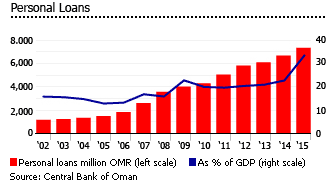
Currently, interest rates on housing loans range from 4% to 6%.
Residential housing loans stand at close to 7% of the banking sector’s total credit portfolio, well within the 15% ceiling stipulated in June 2014, according to the CBO. Before 2006, only two banks were allowed to make housing loans, the government-owned Oman Housing Bank, and the privately-owned Alliance Housing Bank. In 2006, commercial banks generally were permitted to offer housing mortgages. Their lending cap was progressively raised from 5% of total loan portfolio, to the present 15%.
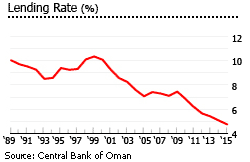
In 2015, Oman’s inflation stood at around 0.18%, according to the IMF, partly due to low global commodity prices. Average inflation was 2.7% from 2009 to 2014. This year, inflation is expected to remain low at 0.25%.
Oil sector still dominates; economic diversification continues
Oman’s diversification plan “Vision 2020” has been quite effective. Petroleum activities’ contribution to Oman’s total GDP in 2015 was just around 33.9%, down from 47.2% of nominal GDP in 2014, 50.6% in 2013, and 52.3% in 2012. The services sector accounted for around 49% of GDP in 2015, a sharp rise from 40.7% in 2014 and 37.7% in 2013.
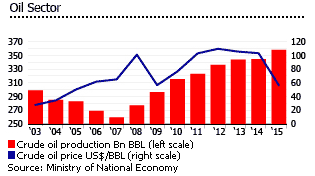
Despite this, oil remains Oman’s top revenue generator. The country’s 3.3% economic growth in 2015 was characterized by a 4% growth in the hydrocarbon sector, compared to a contraction of 0.8% in 2014, according to the World Bank. Likewise, the non-hydrocarbon sector grew by 3% last year.
The decline of the petroleum sector as a percentage of GDP was largely due to the plunge of crude oil prices in 2015 to an average of just US$56.45 per barrel, down more than 45% from US$ 103.2 in 2014. However since then, crude oil prices have declined even further, averaging US$ 36.40 per barrel in the first seven months of 2016.
Oil and gas revenues were equivalent to around 26.4% of GDP in 2015 and accounted for 78.7% of total government revenues. Oil and gas represented about 52.1% of Oman’s total merchandise exports last year.
The 9th Five-Year Plan
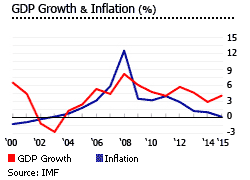
The Omani government recently released its 9th Five-Year Plan (2016-2020), which focuses on social and regional development, economic diversification, welfare and social benefits enhancement, and boosting the private sector.
One feature of the plan is new public-private partnerships (PPPs), including:
- The Mandinat Al Ifran project
- Port Khasab
- Port Sultan Qaboos
- Soth Batinah Logistics Area
In the 2016 approved budget, the budget for housing projects and government subsidies on housing loans dropped substantially, as compared to the previous year’s budget.
Oman had 551,058 housing units in 2010, 27.9% up on 2003. Arabic houses comprised 31.2% of the total housing stock; villas, 28.6%; apartments, 20.9%; rural houses, 3.2%; and improvised housing units, 2.4%.


